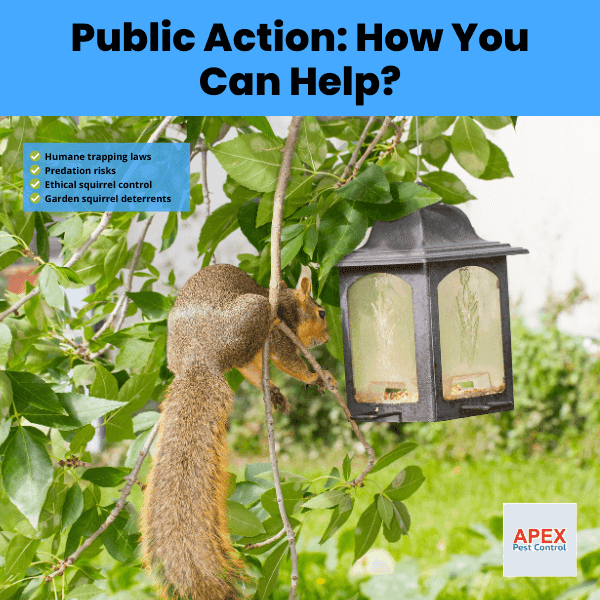Balancing Act: The Environmental Impact of Grey Squirrel Control Measures

The Grey Squirrel Crisis in the UK
“A single wedding gift in 1911 – 12 grey squirrels – now endangers 90% of Britain’s native red squirrels.”
Grey squirrels (Sciurus carolinensis), brought to the UK from North America in the 19th century, rank among Britain’s most damaging invasive species. With 2.7 million greys outnumbering a mere 140,000 red squirrels (Sciurus vulgaris), we must act swiftly to safeguard ecosystems, timber resources, and biodiversity.
Explore proven grey squirrel control techniques in our Grey Squirrel Pest Control Guide, featuring practical removal methods, prevention advice, and expert tips for protecting your property.
Why Grey Squirrels Are a Problem

Damage to Woodlands
- Bark stripping: Greys peel bark from sycamore, beech, and oak trees, costing the UK timber industry £37 million yearly.
- Carbon impact: Affected oaks store 48% less CO₂, aggravating climate change.
| Tree Species | % Damaged | Economic Impact |
|---|---|---|
| Sycamore | 40% | £14M/year |
| Beech | 26% | High timber loss |
| Oak | 6% | Long-term decay |
Threats to Wildlife
- Red squirrel extinction: Greys spread squirrelpox virus (SQPV), lethal to reds.
- Bird declines: Songbird fledglings drop by 15% in grey-heavy woodlands.
“Grey squirrels don’t merely harm trees – they dismantle entire ecosystems.” – Forestry Commission ecologist.
Control Methods: What Works?

Lethal vs. Non-Lethal Strategies
| Method | Cost/Year | Efficacy | Ethical Rating |
|---|---|---|---|
| Trap-and-cull | £2,300/ha | 70% | Moderate |
| Fertility control | £5,000/ha | 30% | High |
| Pine marten reintroduction | £1M (regional) | 50% over 10yrs | High |
Step-by-Step Ethical Trapping
- Deploy cage traps with walnuts or hazelnuts as bait.
- Inspect traps twice daily (a legal must).
- Use an airgun for dispatch (RSPCA-endorsed).
Case Study – Anglesey, Wales:
- 10,000 greys culled since 1998.
- Red squirrel numbers climbed to 700.
Environmental Ripple Effects
Positive Outcomes
- Carbon recovery: Healthy oaks soak up 48% more CO₂.
- Biodiversity boost: Fungal diversity rises 22% in managed zones.
Hidden Risks
- Over-culling could starve predators like goshawks.
- Relocation risks spreading SQPV to new areas (banned under Wildlife Act 1981).
Public Action: How You Can Help

5-Step Garden Protection Plan
- Bird feeders: Fit metal cages with safflower seeds (greys detest them).
- Tree guards: Add spiral protectors to young tree bark.
- Report sightings: Log them on the CEDaR Online Tool at
(https://www2.habitas.org.uk/records/ISI) - Volunteer: Join Red Squirrel Groups (85% patrol locally).
- Avoid feeding greys: Even unintentional scraps fuel their spread.
Myth Buster:
- “Greys are just tougher survivors” → They snatch unripe nuts reds can’t stomach.
The Future of Squirrel Control

Emerging Technologies
- Gene drives: Target grey fertility genes (trials slated for 2030).
- AI monitoring: Camera traps text landowners alerts (piloted in Devon).
Government Targets:
- Cut greys by 50% near red strongholds by 2030.
- £2M in grants for organic repellents.
Questions & Answers
Why can’t red squirrels fight back against grey squirrels?
Red squirrels struggle to compete with grey squirrels for several reasons:
- Size: Grey squirrels are bigger and need more food.
- Food choices: Grey squirrels can eat more types of food, even unripe nuts that red squirrels can’t digest.
- Living spaces: Grey squirrels do well in different forest types, while red squirrels prefer specific habitats.
- Squirrel Pox: Grey squirrels carry a virus that doesn’t hurt them but can kill red squirrels.
- Early eating: Grey squirrels often eat food before it’s ready for red squirrels.
- Numbers game: There are usually more grey squirrels in an area than red squirrels.
- Food theft: Grey squirrels sometimes take food that red squirrels save for winter.
These factors make it hard for red squirrels to survive and grow their populations in areas where grey squirrels live.
Is killing grey squirrels legal?
Yes, in the UK, it’s legal to kill grey squirrels, but there are rules to follow. Grey Squirrels are considered invasive pests that harm native wildlife and damage trees.
Key points about grey squirrel control:
- Humane methods must be used to avoid suffering.
- It’s illegal to release grey squirrels into the wild or keep them as pets.
- If you trap a grey squirrel, you’re required by law to kill it humanely.
- Cruel methods like drowning are forbidden.
Non-lethal options include:
- Using squirrel-proof bird feeders
- Sealing entry points to buildings
- Planting squirrel-resistant plants
Important: Red squirrels are a protected species and must not be harmed. If unsure, consult a wildlife expert for guidance on proper squirrel management.
Do pine martens really control grey squirrels?
Yes, pine martens help control grey squirrel populations. Research shows that areas with pine martens have about 70% fewer grey squirrels. Pine martens are good at catching grey squirrels because:
- Grey squirrels don’t recognise pine martens as a threat
- Pine martens can climb trees and hunt grey squirrels easily
- Red squirrels are better at escaping to thin branches where pine martens can’t go
This natural control helps red squirrels by:
- Reducing competition for food
- Lowering the spread of squirrelpox, a disease that harms red squirrels
Scientists see this as a good thing for the ecosystem. It helps protect native red squirrels and reduces damage caused by invasive grey squirrels to forests and gardens.
How do I protect my roof?
To safeguard your roof:
- Install wire mesh over eaves to deter pests
- Trim overhanging branches, keeping them 10 feet away
- Regularly inspect for damage, especially after storms
- Clean gutters and remove debris seasonally
- Promptly repair any cracks, holes, or loose shingles
- Ensure proper attic ventilation to prevent moisture buildup
- Apply pest repellents around your home’s perimeter
These proactive measures will help maintain your roof’s integrity and extend its lifespan.
Can greys and reds coexist?
Grey squirrels (Sciurus carolinensis) and red squirrels (Sciurus vulgaris) rarely coexist long-term in the same habitat. Greys typically outcompete reds for food resources and carry the squirrelpox virus, which is fatal to reds.
Limited coexistence may occur if:
- Grey population density remains below 5 per square kilometre
- The ecosystem provides distinct niches for each species
- Food sources are abundant for both populations
However, without active conservation efforts, grey squirrels usually displace red squirrels over time in shared environments.
Conclusion: A Balanced Approach
Control greys to save reds and woodlands, but tread carefully to avoid ecological jolts.
- Back ethical control: Donate to Red Squirrel United.
- Spread the word (#SaveRedsUK).
“Saving red squirrels isn’t just about one species – it’s about mending Britain’s forests.”

Tony Johnson, Founder & Lead Technician at Apex Pest Control, is a BPCA and NPTA accredited pest management expert with over 35 years’ hands-on experience. Tony specialises in Integrated Pest Management and ensures all services comply with UK pest legislation, including the Wildlife and Countryside Act 1981 and COSHH Regulations 2002. His commitment to continual learning and adapting to industry best practices means clients receive effective, safe solutions for pests affecting homes and businesses across South Yorkshire. Tony’s dedication to professional standards, ethical treatment methods, and local expertise has made him a trusted partner for pest control and prevention.
-
BPCA & NPTA accredited | CHAS certified
-
Committed to UK pest law compliance & safety
-
Focused on effective, ethical pest management for South Yorkshire


